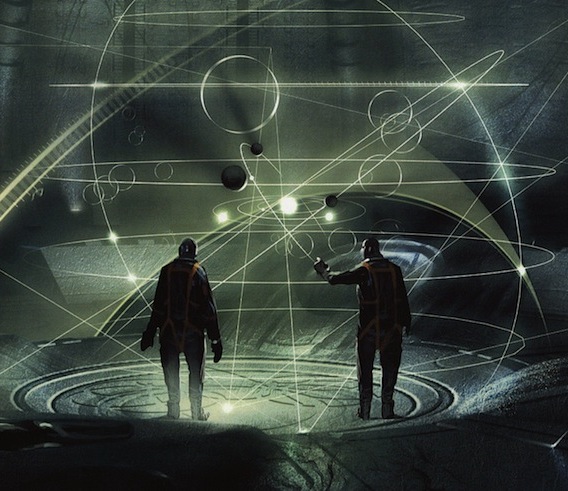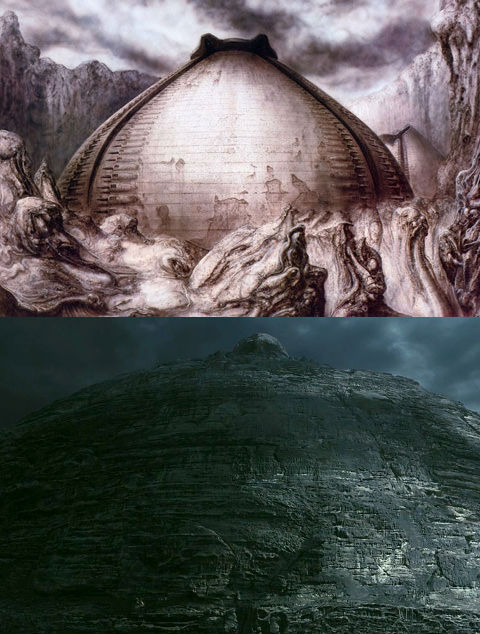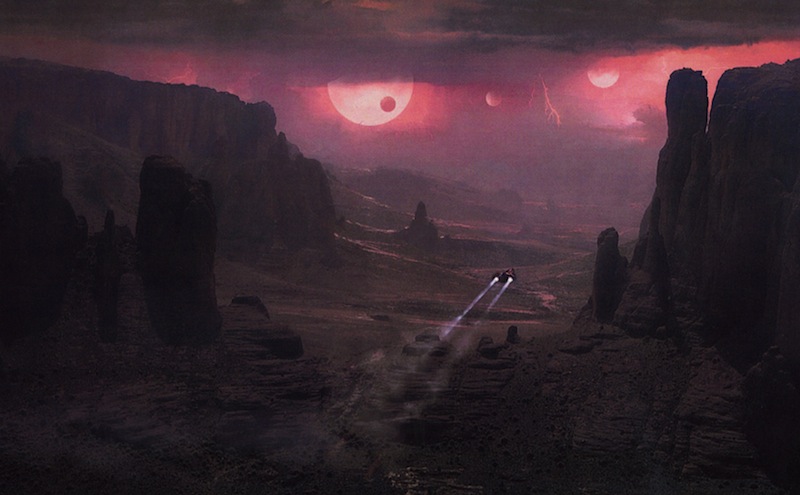 The American Film Institute lists Ridley Scott’s 1979 film Alien as the seventh greatest science-fiction film of all time. Few who have seen the masterpiece of mood and massacre would argue with the praise. Except, maybe, Ridley Scott.
The American Film Institute lists Ridley Scott’s 1979 film Alien as the seventh greatest science-fiction film of all time. Few who have seen the masterpiece of mood and massacre would argue with the praise. Except, maybe, Ridley Scott.
“There are certain things that bug him from the old film,” reveals Steven Messing, the concept artist and visual effects art director for Scott’s latest film Prometheus. The director’s misgivings surprised Messing, a fan of Alien who has worked with Scott on several of the director’s films, including design-heavy epics like Avatar, Alice in Wonderland and the upcoming OZ: The Great and Powerful. “It was wild to be in these conversations with him. Thirty years ago, because of budgetary constraints, he had to go with what they built on set for a lot of things. He never really got a chance to polish those designs.”
Scott, who started as a production designer in the UK before he began a directing career, was drawn back into the Alien universe, in part, thanks to the design-friendly world of sci-fi. Messing was brought on early in the process, before the movie had funding, before the film had a name (“they called it different things at different times…. Paradise, Tomb of the Gods….”) and even before there was a finished script. Messing papered Scott’s office with art, catching him up on the last thirty years of cinematic science fiction and exploring the alien environments touched upon in Alien. Once ideas started flowing, Scott even joined in on the action. “Ridley would come and draw with us, which was unique. I had never had a director sit down, literally next to me, and draw ideas at the same time. He has very good drafting skills. He storyboards all his own films.”
The stunning creature and architecture designs of the original ’70s Alien were born from the imagination of H.R. Giger, and while the surrealist artist’s work was an inspiration to Messing, Scott was apparently “was very adamant about not doing the same thing.”  “There is a lot of very organic design work that Giger did,” Messing explains. “If you look, there are similar sets, like the pilot chamber set in our film. It’s from the same world, but it’s not the same exact set. It’s a little more mechanical. The filigree on it is a bit cleaner and less organic. A lot of those changes in aesthetic…Ridley would call the old Giger stuff porkchops.”
“There is a lot of very organic design work that Giger did,” Messing explains. “If you look, there are similar sets, like the pilot chamber set in our film. It’s from the same world, but it’s not the same exact set. It’s a little more mechanical. The filigree on it is a bit cleaner and less organic. A lot of those changes in aesthetic…Ridley would call the old Giger stuff porkchops.”
According to Messing, even the original film’s iconic imagery could be improved through Prometheus‘ modern technology and afforded design time. “He was never that much in love with the facehugger. He thought it was goofy and never really liked it.” A set in Prometheus, the epically scaled “pilot chamber” seen in the trailers, takes its cues from a location in Alien where a mysterious creature (dubbed the Space Jockey) was found sitting in a humongous chair. “There’s the flooring… I spent a lot of time redesigning that whole set. He hated it because they basically took a bunch of plumbing and pipes that they found and laid it out on the ground. He walked in there and that’s what he saw and he couldn’t change it.”
Scott’s emphasis on redesign didn’t wipe the existing aesthetic completely clean. In some instances, Messing and his team went back to Giger’s original sketches to realize ideas that never made it into the original. “There’s lots of little detailing on the pilot’s chair that was lost in that original sculpt in that original chair. We had Academy references that we pulled form the archives of set photos of that construction, and we compared them to Giger’s original layout for that design.” Prometheus also features a construction originally intended for Alien (which Giger’s attempted to utilize in later projects, like the ill-fated Alejandro Jodorowsky adaptation of Dune). “The big pyramid mound that you’ve seen in the trailer. It’s almost like a sphinx head, an eroded face. He called it the Pyramid. The compound mound. Some of that is from old Giger drawings from different books. There was development work early on in Alien where they’re talking about these pyramid structures, and aliens had engineered man and kind of did it in these big compound pyramids. He toyed with it a long time ago, but he wanted to reintroduce it here.”
A fully realized set rarely captures the beauty of concept art created for a major blockbuster, but Messing promises the beauty of a lush drawing remains intact in Prometheus large-scale locations. “The pilot chamber room, I did most of the design work on it.  You’ll see this desk console that David the Android sits down at an activate, it brings up these holograms — you see it in the trailer — all those sleeping pods, I sculpted all of that in 3D and then gave them sectional layouts and the construction crew literally traced over them. Blew them up and built off of them. When I walked on the set, I had been spinning my model in 3D software for months, and then I was walking on it. I’d say 95% of that set was accurate.”
You’ll see this desk console that David the Android sits down at an activate, it brings up these holograms — you see it in the trailer — all those sleeping pods, I sculpted all of that in 3D and then gave them sectional layouts and the construction crew literally traced over them. Blew them up and built off of them. When I walked on the set, I had been spinning my model in 3D software for months, and then I was walking on it. I’d say 95% of that set was accurate.”
Messing describes Scott as a meticulous director read to make changes at the drop of a hat. “If he feels like a design is hindering his storytelling, he will throw it out.” Whereas some directors shoot tons of green screen and give themselves the option to tinker after a shoot, Scott is about reality — and that means building sets, and occasionally, rebuilding them. “We’d be laying out working drawings and it would literally be weeks away from being built, and he would change the entire set. I’ve never had that experience where they’ll combine two sets to save money, which happens all the time, but they’ll do it two weeks before.” Scott’s insistence on tangibility in his alien worlds extended to the exteriors too. Prometheus shot on location in Iceland to mimic the surface of a distant planet, a vista Messing drew beforehand just to Scott’s liking. “If you look at the first Alien, or even James Cameron’s second one, you’ll see there’s a lot of pinnacle rock formations in the distance. Ridley had said, ‘these are too whimsical.’ He doesn’t want big fantasy structures in this film. You’ll see mini versions of those, but they’re scaled back. I was so excited to get in the art department, my first week I was doing some big dramatic landscapes, and he said, ‘these are great Steve, but…’ They were too sci-fi. He wanted something that looked like he went and shot. It has to be more real than some of the stuff in the original Alien.”
With Scott’s attention to detail and demand for balance between fantasy and reality, Prometheus may sound stripped of its awe-inspiring otherworldliness. Not so. After seeing the film, the same word floated around my mind as I soaked in the visuals on display in the modern sci-fi epic as it did when Messing saw his drawings turned into life-size sets at England’s famous Pinewood Studios. “Amazing.” Whether Scott thinks he fixed Alien or not, he’s certainly created something we really haven’t seen since…well, Alien!
Follow Matt Patches on Twitter @misterpatches
More:
‘Prometheus’ and Defying the R-Rated Blockbuster Odds
Sneak Peek: Mysterious Missions, Angry Aliens, & Reflective Robots in ‘Prometheus’ — CLIPS
‘Prometheus’: New Trailer Brings Up More Mysteries — VIDEO
[Photo Credit: 20th Century Fox, H.R. Giger]



